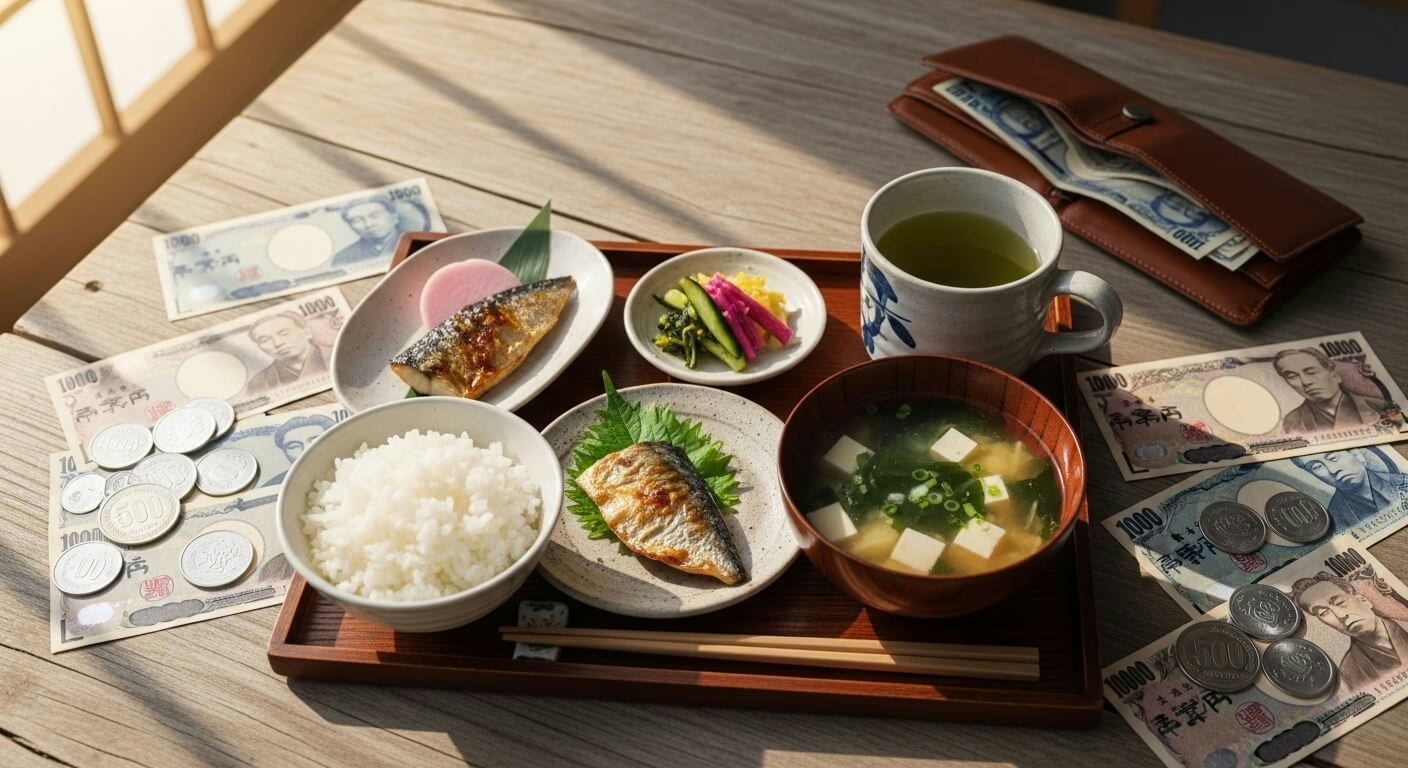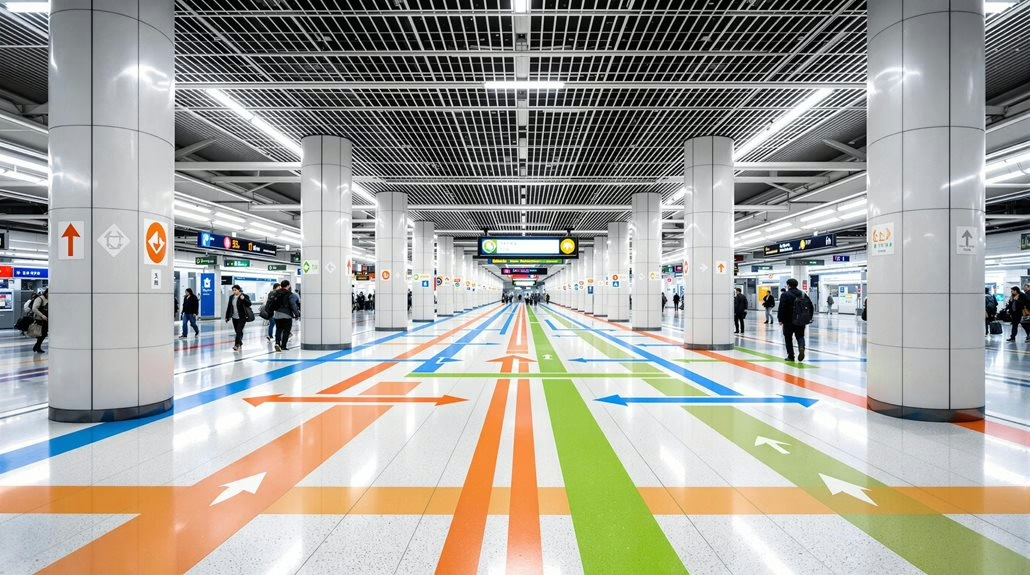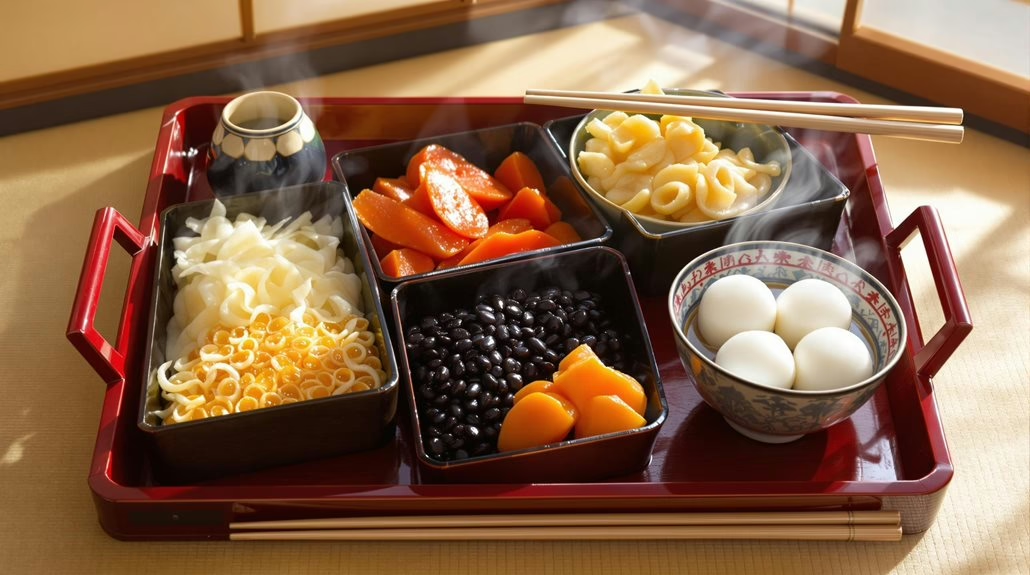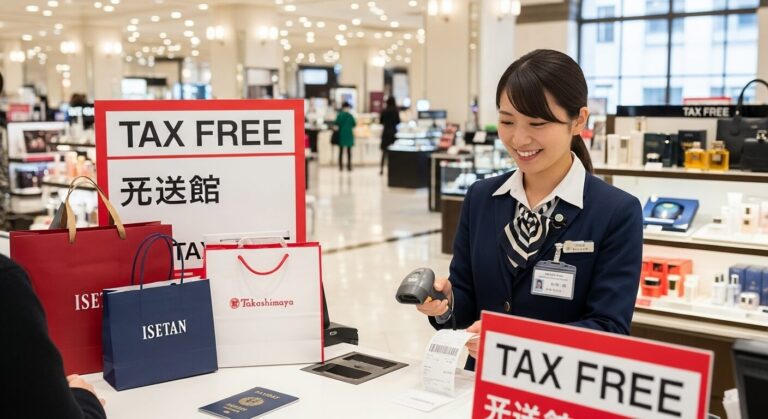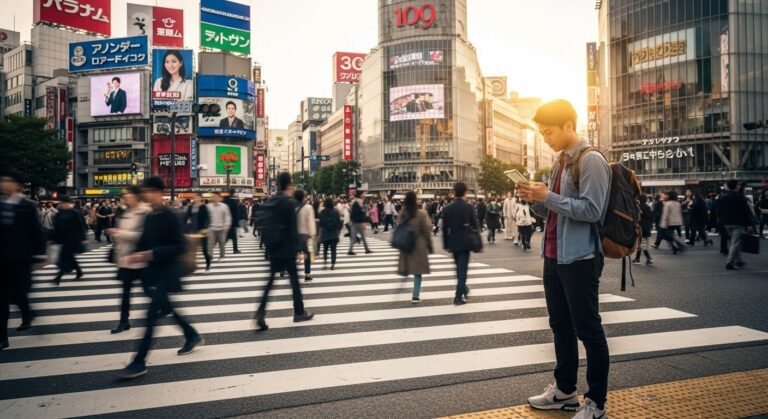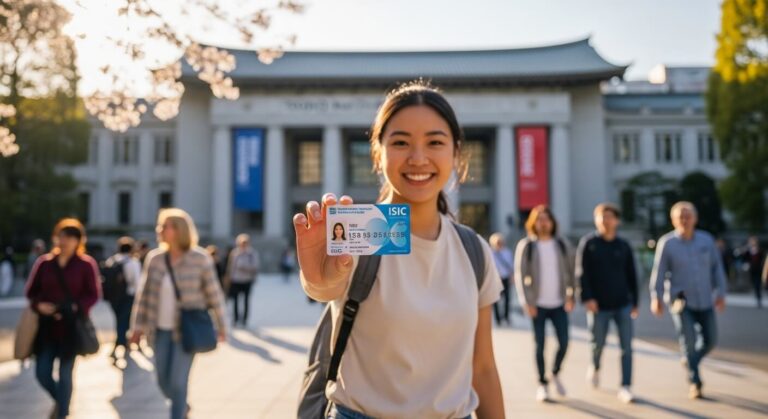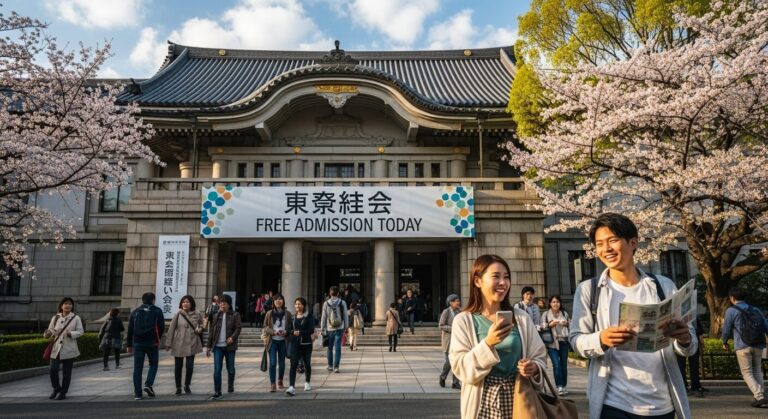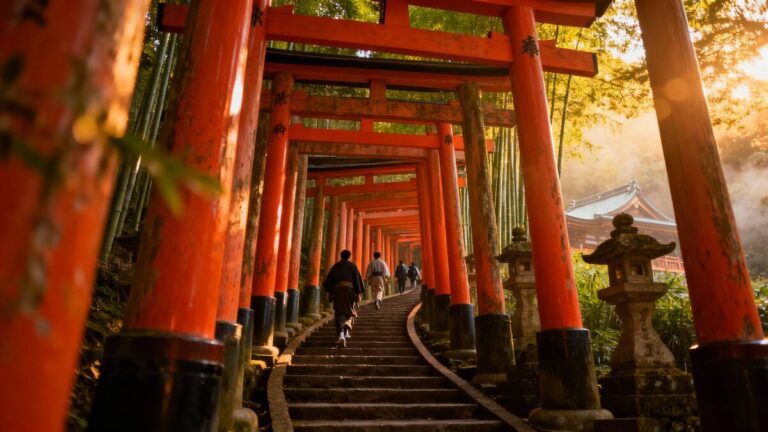Tokyo Budget Guide: ¥5,000 Daily Breakdown & Tips
Tokyo on ¥5,000 daily breaks down beautifully: ¥2,000 for capsule hotels or hostels, ¥800 for transportation using IC cards and strategic walking, ¥1,500 for meals from konbini bento boxes and lunch sets, and ¥700 for entertainment at free temples like Senso-ji and observation decks.
The secret?
Shop at 100 yen stores, hit happy hours at tachinomi bars for ¥300 beers, and walk between neighborhoods like Harajuku to Shibuya to discover hidden gems while saving train fares.
Trust me, this budget actually works!
The complete breakdown ahead reveals exactly how to maximize every yen across accommodations, dining, sightseeing, and those unexpected expenses.
Key Points
Hide- Budget accommodations like capsule hotels, hostels, and business hotels cost around ¥2,000 nightly, leaving ¥3,000 for daily activities.
- Use IC cards for transit and walk between neighborhoods to save money while discovering hidden local gems.
- Eat affordable meals at convenience stores, lunch sets for ¥800-1,200, and happy hour izakayas with discounted drinks.
- Visit free attractions including Senso-ji Temple, Meiji Shrine, parks, and observation decks at government buildings for city views.
- Shop at 100 yen stores for souvenirs and haggle at markets like Ameya-Yokocho after 5 PM for better deals.
Breaking Down Your Daily ¥5,000 Budget Like a Pro
Living well in Tokyo on just ¥5,000 per day might sound impossible, but trust me, it’s totally doable when you know where to spend your yen!
The secret is breaking down your budget into three main chunks: around ¥1,500-2,000 for a comfy place to crash, ¥800 or less for zipping around the city, and another ¥1,500-2,000 for filling your belly with amazing food.
Tokyo Trip Add-Ons
Equip yourself for the ultimate Tokyo adventure with the following add-ons, curated just for you.
Master these three categories, and you’ll be exploring Tokyo like a savvy local instead of a stressed-out tourist watching their bank account drain with every subway ride!
Accommodation That Won’t Break the Bank: ¥1,500-2,000 Options

Finding a decent place to crash in Tokyo for ¥1,500-2,000 per night might sound impossible, but trust me, it’s totally doable if you know where to look!
This price range covers everything from futuristic capsule hotels (think sleeping pods straight out of a sci-fi movie) to friendly hostels where you’ll actually meet other travelers.
Plus, surprisingly comfortable business hotels that cater to budget-conscious Japanese salarymen are also available.
- Tokyo WiFi Guide: Free Hotspots & Pocket WiFi Tips
- Tokyo New Year’s Guide: Shrine Visits & Holiday Traditions
- 10 Must-Know Tokyo Metro Shortcuts for Travelers
- Tokyo SIM Card Guide: Best Plans for Travelers
- 19 Best Free Things to Do in Tokyo
- Useful Japanese Travel Phrases to Know Before Traveling to Tokyo
The secret is understanding that Tokyo’s accommodation scene works differently than back home—smaller doesn’t mean worse, and “budget” definitely doesn’t mean sketchy.
Capsule Hotels: Your Gateway to Authentic Tokyo Living
When most travelers picture capsule hotels, they imagine sci-fi pods straight out of a space station—but here’s the thing: these compact sleeping quarters are actually one of Tokyo’s smartest budget hacks, and they’ll only set you back ¥1,500-2,000 per night!
Trust me, capsule hotels deliver an authentic Tokyo experience while keeping your wallet happy.
You’ll find clean sheets, charging stations, and often communal lounges where you’ll meet fellow adventurers exploring this incredible city.
Hostels with Character: Social Stays Under ¥2,000
Tokyo’s hostel scene has absolutely exploded in recent years, transforming from basic bunk beds into lively community hubs where budget travelers swap stories over complimentary tea and plan their next adventures together.
You’ll find spots decorated with local art, rooftop bars, and some even feature themed cafes downstairs.
These aren’t just crash pads—they’re launching points for exploring Tokyo your way, completely unchained from rigid tourist schedules!
Business Hotels: Comfort Meets Affordability
Why settle for cramped hostel bunks when business hotels offer private rooms, actual bathrooms, and reliably strong wifi for barely ¥500 more per night?
These local business staples cater to salarymen but welcome budget travelers seeking affordable luxury.
Chains like Toyoko Inn and APA Hotels deliver spotless rooms around ¥2,000—your own space, your own schedule, nobody’s snoring to deal with.
That’s freedom worth five hundred yen!
Transportation Mastery: Getting Around for ¥800 or Less
Transportation costs can absolutely destroy a tight budget if you’re not careful, but here’s the good news: Tokyo’s system is so efficient that smart travelers can explore the entire city for less than the price of a fancy coffee back home.
The secret isn’t buying expensive tourist passes that promise unlimited travel (spoiler alert: you won’t use them enough to break even).
Instead, it’s about understanding which local options actually work for budget travelers, knowing when your own two feet beat any train, and mastering a few insider tricks that keep your daily transport spending under ¥800 while still seeing everything worth seeing.
JR Pass Alternatives That Actually Save Money
The infamous JR Pass gets touted as the ultimate money-saver for Japan travel, but here’s the truth that’ll save you some serious yen: if you’re staying mainly in Tokyo, it’s actually a terrible deal!
Your best JR Pass alternatives?
Grab a rechargeable IC card (Suica or Pasmo) instead.
- Tokyo Free Museum Days: When to Visit Without Paying
- Monthly Tokyo Living: Budget Tips for Long Stays
- 10 Must-Know Tokyo Metro Shortcuts for Travelers
- Full-Day in Tokyo: Perfect for Couples on a Luxury Budget
- Tokyo Ramen Shop Etiquette: Ordering, Eating & Paying
- Tokyo Onsen Etiquette: Hot Spring Rules & Cultural Significance
These travel card options let you pay-as-you-go, tapping through subway gates like a local while avoiding that ¥30,000+ pass expense.
Local Train Tricks Every Budget Traveler Should Know
So you’ve got your IC card loaded up and ready to tap—now let’s talk about actually using Tokyo’s train system without hemorrhaging money every time you step on a platform.
Here are the local train hacks that’ll keep you mobile and solvent:
- Walk one station when possible—saves ¥170 and burns off those ramen calories
- Download train ticket discounts through apps like JapanTaxi for off-peak rewards
- Avoid express trains requiring surcharges; local trains reach everywhere eventually
- Transfer strategically within the same line to minimize fares
Walking Routes That Save Yen and Show Hidden Gems
Walking between Tokyo neighborhoods isn’t just free transportation—it’s where budget travelers stumble onto their best stories.
The Yanaka to Ueno route passes through hidden alleys filled with local taverns charging ¥300 for beer instead of ¥800.
Harajuku to Shibuya?
That’s prime people-watching territory.
Trust me, these walks reveal Tokyo’s soul while your wallet stays fat and happy!
Eating Like a Local Without Emptying Your Wallet: ¥1,500-2,000
Tokyo’s food scene doesn’t have to drain your wallet—in fact, some of the most authentic and delicious meals cost less than a movie ticket back home!
Budget travelers can easily keep their daily food spending between ¥1,500-2,000 (roughly $10-13) while eating incredibly well, from filling convenience store bento boxes to bustling standing bars where locals actually hang out.
The secret is knowing where to look and when to strike, because timing your meals around lunch sets and happy hour specials can mean the difference between tourist prices and local deals.
Convenience Store Meals That Taste Amazing
Japan’s convenience stores—known locally as *konbini*—are about to become a traveler’s best friend and secret weapon for staying under budget.
These local convenience stores pack serious flavor at unbeatable prices.
Trust me, 7-Eleven isn’t your hometown version!
Top affordable meal options that’ll blow your mind:
- Onigiri rice balls (¥100-150): Tuna mayo, salmon, or plum—breakfast perfection
- Fresh bento boxes (¥400-600): Complete meals with rice, protein, veggies
- Oden hot pot (¥100-200 per item): Winter comfort food heaven
- Egg sandwiches (¥200): Fluffy, creamy, surprisingly addictive
Standing Bars and Cheap Eats in Every Neighborhood
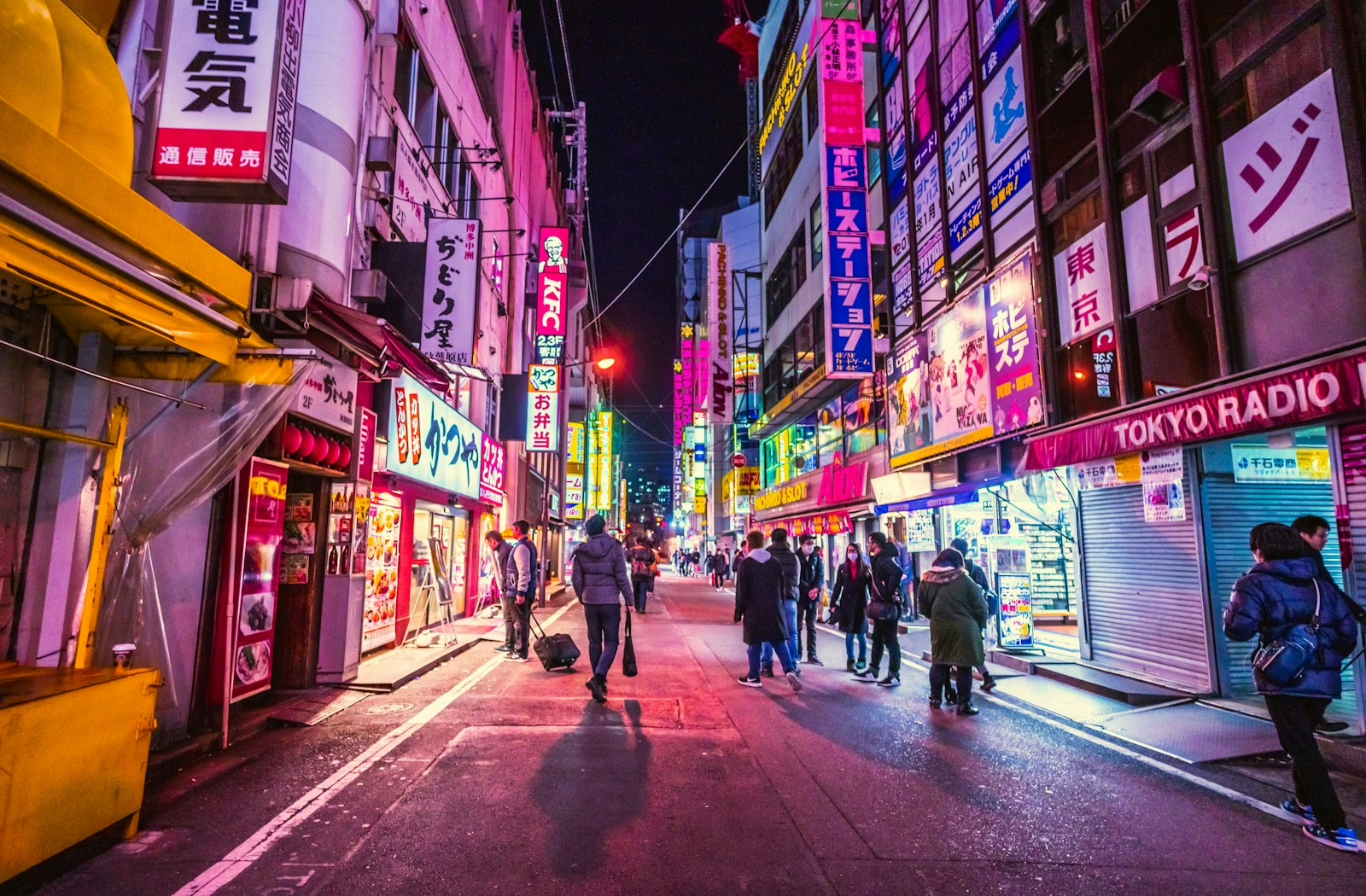
When the sun sets over the city, a whole different side of Tokyo’s food scene comes alive—and it’s not the expensive sit-down restaurants tourists usually think about.
Standing bars (tachinomi) pack every neighborhood with ¥300 beers and grilled skewers.
Trust me, local bar hopping beats fancy dining any day!
Check neighborhood guides for yakitori joints in Shibuya or Shinjuku’s Golden Gai—cheap, delicious, and unforgettable.
Lunch Sets and Happy Hour Deals You Can’t Miss
The secret weapon every budget traveler needs is understanding Japan’s lunch set culture—and honestly, it’s where the magic happens!
Teishoku lunch sets run ¥800-1,200 and include everything you need.
- Department store basements offer premium bentos at 50% off after 7 PM
- Local izakaya happy hours (5-7 PM) feature ¥300 drinks and discounted appetizers
- Sake tasting at standing bars costs just ¥500 for three varieties
- Conveyor belt sushi lunch specials deliver quality fish for ¥1,000
Smart Shopping and Entertainment on a Shoestring Budget
Tokyo’s entertainment scene doesn’t have to drain your wallet—in fact, some of the city’s most memorable experiences are completely free!
The key is knowing where to look and setting firm spending limits (like a daily ¥500 cap for souvenirs) that let you bring home memories without the financial regret.
Trust me, once you discover the hidden parks, free observation decks, and budget-friendly neighborhoods that locals actually enjoy, you’ll wonder why anyone pays ¥3,000 to stand in line at overcrowded tourist attractions.
Free Activities That Beat Expensive Tourist Traps
Tokyo’s best experiences don’t come with hefty admission prices—they’re absolutely free!
While tourists drop serious cash at observation deck chains and commercialized attractions, savvy travelers discover that the city’s most authentic moments happen at neighborhood temples, local parks, and cleverly chosen viewpoints that locals have known about forever.
Also read: Best Free Things to Do in Tokyo
The secret isn’t just saving money (though your wallet will thank you)—it’s about experiencing Tokyo the way residents actually live it, which turns out to be way more interesting than following the typical tourist checklist anyway.
Temple Hopping: Spiritual Experiences That Cost Nothing
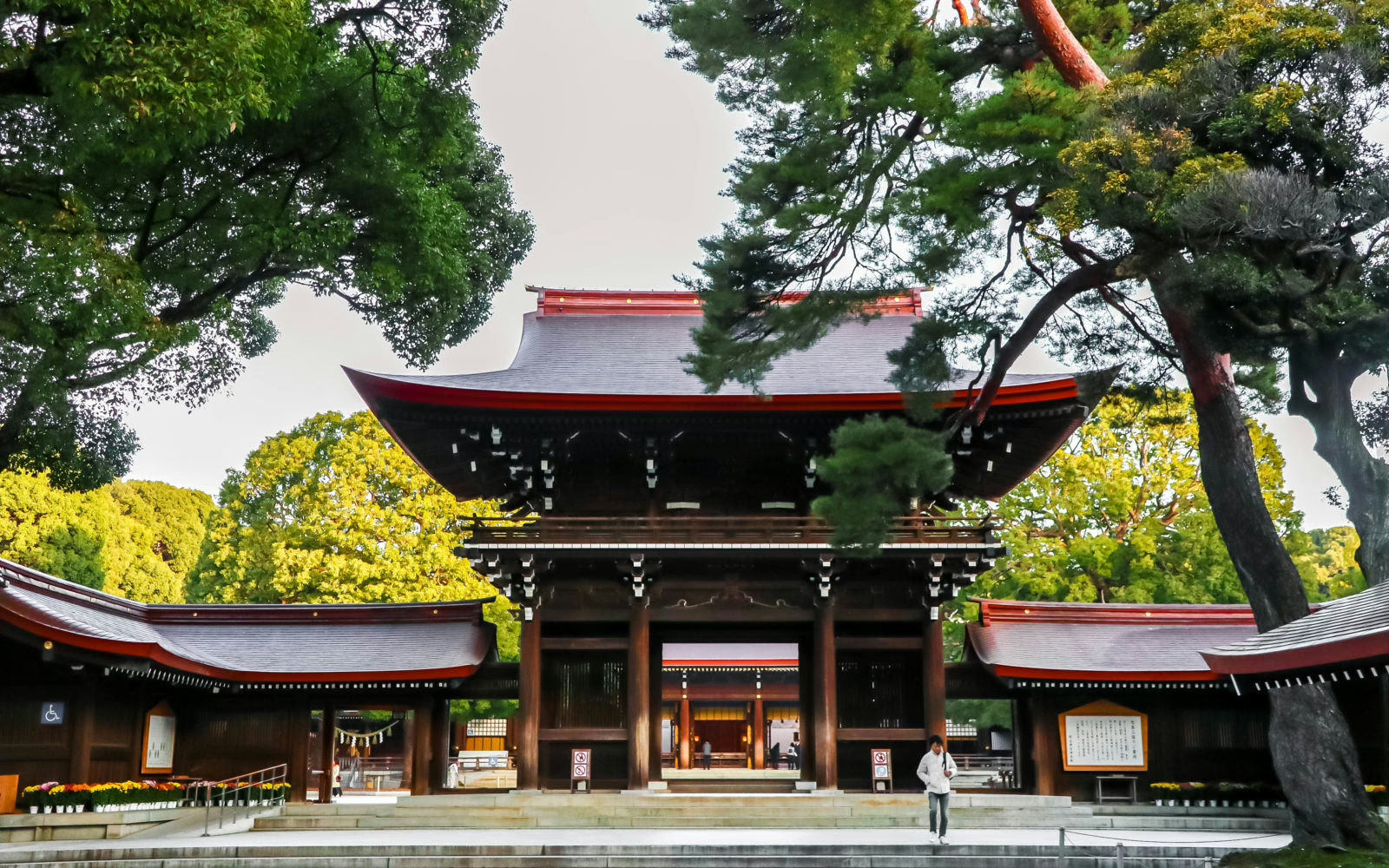
Wandering through Tokyo’s ancient temples won’t cost you a single yen, and honestly, these spiritual spots might just become the highlight of your entire trip!
- Senso-ji Temple in Asakusa offers stunning temple architecture and zero admission fees.
- Meiji Shrine provides peaceful mindful meditation opportunities among towering trees.
- Nezu Shrine features incredible vermillion gates without crowds.
Early morning visits mean fewer tourists and better photos!
Parks and Gardens Where Locals Actually Hang Out
Why spend money on manicured tourist gardens when the city’s best green spaces are completely free and packed with actual Tokyoites doing their thing?
Yoyogi Park explodes with energy—picnickers, dancers, musicians creating spontaneous performances.
Shinjuku Gyoen offers stunning Japanese gardens (small admission fee, worth it).
Ueno Park hosts incredible park festivals year-round.
Trust me, locals choose these spots for good reason—they’re authentic, free, and endlessly entertaining!
Observation Decks and City Views Without the Price Tag

How much would someone pay for a Tokyo skyline view?
Zero yen, actually!
Forget those expensive observation decks when free alternatives exist everywhere.
- Tokyo Metropolitan Government Building – Twin towers offering identical skyline vistas to pricey competitors
- Carrot Tower – Setagaya’s hidden 26th-floor gem with rooftop gardens
- Bunkyo Civic Center – Free Mount Fuji views on clear days
- Shibuya Scramble Square rooftop – Free outdoor terrace beats indoor tickets
Trust me, your wallet will thank you!
Strategic Souvenir Shopping: ¥500 Maximum Daily Splurge
Shopping for souvenirs in Tokyo doesn’t mean emptying your wallet at the airport gift shop—trust me, there are way smarter ways to bring home authentic Japanese treasures without breaking your ¥500 daily budget!
The secret lies in knowing where locals actually shop (hint: those magical 100 yen stores are absolute goldmines), which markets welcome a friendly haggle, and exactly when to pounce on the best deals.
Master these three strategies, and you’ll return home with a suitcase full of quality Japanese goods while your friends who hit the tourist traps are still explaining their credit card bills.
¥100 Stores That Sell Quality Japanese Goods
Japan’s famous 100-yen stores are absolute goldmines for budget travelers who want authentic Japanese products without the department store markup.
Trust me, these places stock legitimate Japanese crafts and traditional textiles that’ll make your friends think you splurged!
- Daiso – The undisputed king with origami paper, tea accessories, and adorable bento supplies
- Seria – Heaven for craft lovers and minimalist aesthetic fans
- Can Do – Hidden gem for traditional snacks
- Watts – Budget skincare products galore
Local Markets Where Bargaining Actually Works
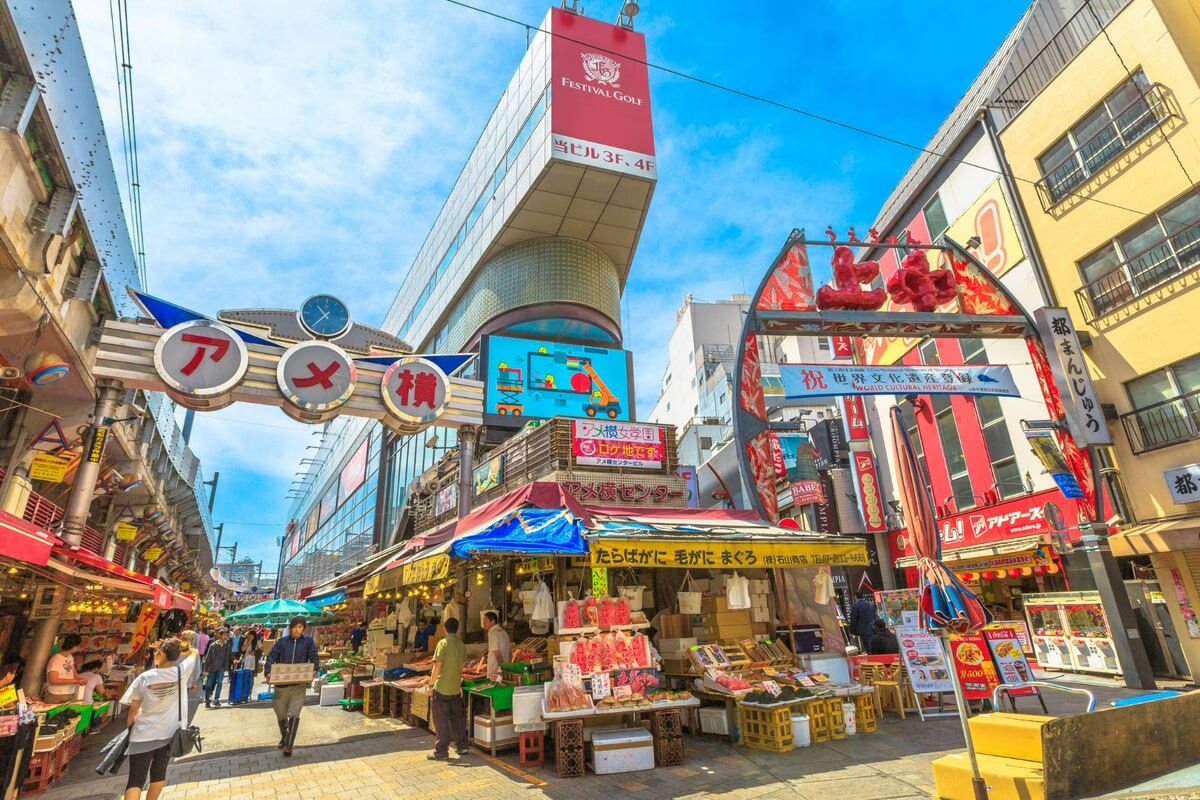
Unlike most tourist-friendly cities where “fixed prices” reign supreme, certain Tokyo markets still embrace the ancient art of haggling—but you’ve got to know exactly where to go and how to play the game!
Ameya-Yokocho (Ameyoko) near Ueno Station transforms into bartering souvenirs heaven after 5 PM when vendors desperately slash prices.
Start at 60% of asking price—trust me, market bargaining works brilliantly here, especially for bulk purchases of snacks, chopsticks, and tea!
Timing Your Purchases for Maximum Savings
Timing is everything for maximizing your freedom to explore without breaking the bank.
Smart souvenir shopping and meal prep strategies can stretch that ¥500 daily splurge incredibly far!
- Evening grocery runs (after 7 PM) score 50% discounts on ready-made meals
- End-of-season sales at Don Quijote offer unbeatable souvenir deals
- Weekday mornings mean quieter shops and better bargaining opportunities
- Last Sunday monthly brings tax-free shopping events
Neighborhood-Specific Budget Strategies That Work
Each Tokyo neighborhood has its own personality, and guess what?
They also have unique money-saving opportunities that savvy travelers can totally exploit!
From Shibuya’s free street fashion shows to Asakusa’s centuries-old budget traditions, knowing where to find the deals makes all the difference between blowing your budget in two days or stretching it for two weeks.
The secret isn’t avoiding these famous areas—it’s knowing exactly how to experience them without emptying your wallet.
Shibuya and Harajuku: Youth Culture on the Cheap

Shibuya and Harajuku might look like expensive playgrounds for Tokyo’s trendiest youth, but here’s the secret: these neighborhoods actually offer some of the best budget opportunities in the city if you know where to look.
Students and young travelers can score legitimate discounts at dozens of shops and attractions just by flashing a student ID or passport (seriously, always ask—the worst they can say is no!).
Beyond the savings, the real treasure is the incredible street food scene where you can fill up on everything from crispy takoyaki to fluffy cream puffs for less than ¥500 per item.
Student Discounts and Young Traveler Perks
Why pay full price when student status opens a treasure trove of discounts across Shibuya and Harajuku?
- Museums and galleries slash prices 20-50% with valid student ID—even international cards work!
- Clothing stores like WEGO offer additional student discounts on already affordable pieces
- Cafes and restaurants near universities provide student meal sets (gakusei teishoku) for ¥500-700
- Karaoke chains give student rates during off-peak hours, sometimes half-price!
Trust me, flash that card everywhere!
Street Food Adventures Under ¥500
Forget expensive sit-down restaurants—the real culinary magic in these neighborhoods happens on street corners and tiny storefronts where ¥500 becomes a full meal.
Takeshita Street serves up crepe heaven for ¥400!
Local street snacks like karaage (fried chicken) and taiyaki (fish-shaped pastries) deliver maximum flavor without destroying your budget.
These ¥500 bites fuel entire afternoons of exploration.
Trust me, you’ll eat better than tourists paying triple.
Asakusa and Traditional Tokyo: Old-School Savings
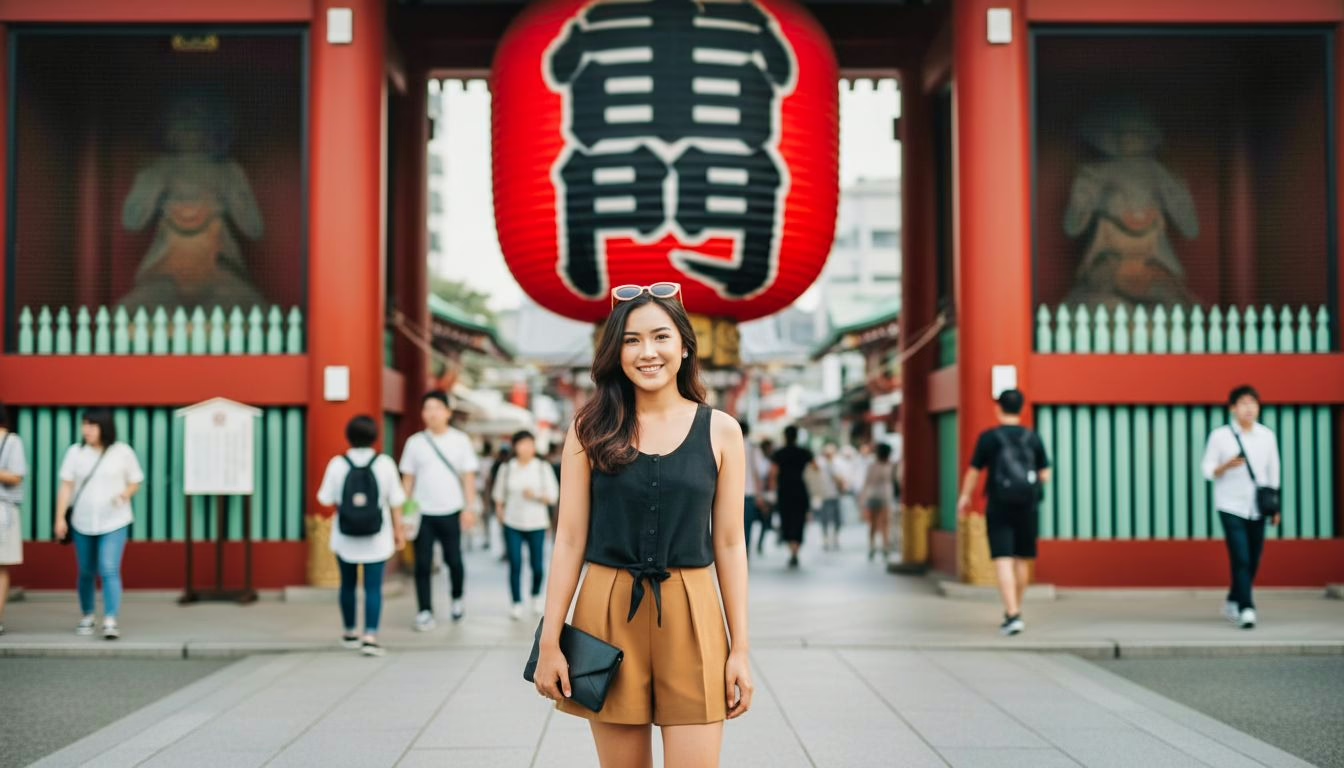
Asakusa proves that experiencing traditional Tokyo doesn’t require splurging on expensive tea ceremonies or kaiseki dinners—this historic neighborhood offers authentic cultural immersion at prices that’ll make your wallet sing.
The area around Sensō-ji Temple bursts with free experiences, from watching craftspeople practice centuries-old trades to catching impromptu performances by street musicians and traditional dancers.
Even better, the neighborhood’s festival calendar runs year-round, meaning you can witness elaborate matsuri celebrations, sacred rituals, and seasonal events without spending a single yen on admission!
Traditional Experiences That Don’t Cost a Fortune
How can travelers experience Tokyo’s rich cultural heritage without emptying their wallets in the process?
Asakusa delivers authentic moments without the hefty price tag.
Traditional crafts and cultural workshops thrive here at surprisingly reasonable rates.
Budget-Friendly Traditional Experiences:
- Free temple grounds exploration at Senso-ji (zero yen!)
- Affordable origami and calligraphy cultural workshops (¥500-1,500)
- Traditional crafts shopping at Nakamise Street
- Complimentary kimono viewing throughout the neighborhood
Local Festivals and Free Cultural Events
Throughout the year, Tokyo’s festival calendar transforms public streets into spectacular cultural showcases—completely free of charge.
Local festivals like Sanja Matsuri bring massive parades, traditional dancing, and portable shrines right to your doorstep.
Cultural events at temples and shrines offer everything from taiko drumming to tea ceremonies without tickets.
Check neighborhood bulletin boards or ask your hostel staff—they’ll point you toward weekend celebrations most tourists completely miss!
Shinjuku After Dark: Nightlife Without the Nightmare Bills
Shinjuku‘s neon-lit streets might look expensive, but the neighborhood actually hides some of Tokyo’s best nightlife bargains if you know where to look.
The secret?
Karaoke chains offer ridiculous deals during off-peak hours (we’re talking ¥100-300 per person for the first hour), and those cramped singing rooms become even cheaper when you split costs among friends.
After you’ve belted out your favorite J-pop hits, the real adventure begins with Shinjuku’s legendary late-night food scene.
Tiny standing bars and ramen joints serve up filling meals for under ¥1,000—sometimes way under!
Karaoke Deals and Group Discounts
Karaoke in Shinjuku can actually be one of the cheapest ways to spend an evening if you know how to game the system.
Split costs among friends and suddenly you’re paying ¥300-500 per hour instead of dropping serious cash at bars!
Smart karaoke deals to grab:
- Nomihoudai packages – All-you-can-drink deals (¥1,500-2,000 for 3 hours)
- Late-night “free time” – Midnight to 5am flat rates around ¥1,200
- Group discounts – 4+ people save 20-30%
- Weekday promotions – Half-price rooms before 6pm
Late-Night Food Adventures Under ¥1,000
After belting out your heart at karaoke, hunger hits different around midnight – and here’s the beautiful truth about Shinjuku: the best cheap eats come alive when most tourists are already tucked in bed.
Ramen yokochos (alley clusters) serve steaming bowls for ¥680-850, while 24-hour gyudon chains like Yoshinoya dish out budget friendly snacks under ¥500.
Convenience store onigiri?
Pure late night eats genius at ¥120 each!
Weekly Budget Planning and Emergency Fund Tips
Managing money week by week in Tokyo requires a smart game plan that actually works in real life—not just on paper!
The secret is breaking down your monthly budget into weekly chunks that account for Tokyo’s unpredictable expenses (because let’s be honest, you will find that perfect ramen shop on Thursday night).
And here’s the thing nobody tells you: having an emergency stash for when you inevitably blow past your konbini budget isn’t admitting defeat—it’s just smart planning that’ll save you from panicking when payday is still five days away.
Stretching Your Yen Across Seven Days
Smart weekly planning in Tokyo can turn a tight budget into a comfortable adventure, and it starts with two game-changers: knowing exactly what you’ll eat each day and buying the right transportation pass.
Most visitors blow their yen by grabbing random meals at convenience stores (which adds up fast!) and paying for individual train rides like they’re collecting expensive receipts.
The good news?
A little Sunday planning session—mapping out your meals and calculating whether a weekly pass beats single tickets for your actual itinerary—can save you thousands of yen that’ll feel like found money in your pocket!
Meal Planning Strategies for Consistent Savings
How can travelers transform their Tokyo food budget from a daily guessing game into a rock-solid financial strategy?
Smart meal planning open doors to authentic cultural experiences without breaking the bank:
- Scout convenience stores for ¥300-500 breakfast sets featuring onigiri and tea
- Hit local food markets before 2 PM for discounted bento boxes
- Reserve sit-down meals for lunch when restaurants offer gentei teishoku specials
- Stock protein-rich snacks to avoid expensive impulse purchases
Transportation Passes That Actually Pay Off
Why do most tourists burn through ¥5,000 on transportation while savvy travelers spend just ¥2,000 for the same week?
The secret lies in choosing passes that match actual travel patterns rather than falling for marketing hype.
Smart pass comparisons reveal the 72-hour Tokyo Subway Ticket (¥1,500) beats daily tickets if you’re hitting three+ destinations daily.
Track your planned routes first—transportation discounts only work when they align with your adventure map!
Emergency Backup Plans When You Overspend
Even the most careful budgeters occasionally splurge on that irresistible ramen or spontaneous karaoke session—and suddenly, you’re staring at your wallet wondering where all those yen disappeared to!
The good news is that Tokyo offers countless free activities that can help you reset your spending without feeling like you’re missing out on the fun.
Combining these zero-cost options with a few smart money-saving adjustments means you can get your budget back on track within a day or two.
Turning that “oops” moment into just a minor hiccup in your Tokyo adventure.
Free Activities to Reset Your Budget
When travelers blow their budget in Tokyo—and trust me, it happens to even the most disciplined planners—the city offers an incredible safety net of completely free activities that can help reset spending habits without sacrificing the adventure.
- Explore local art galleries in Roppongi and Ginza offering free admission days
- Wander through seasonal cultural festivals celebrating everything from cherry blossoms to harvest traditions
- Discover hidden shrine complexes and peaceful temple gardens throughout neighborhoods
- Experience lively street performances in Yoyogi Park and Shibuya’s pedestrian zones
Quick Money-Saving Adjustments That Actually Work
Budget emergencies don’t announce themselves with flashing neon signs—they creep up slowly, usually around day five of a ten-day trip when someone realizes they’ve somehow spent ¥30,000 on vending machine drinks and random konbini snacks.
First move?
Stop using hotel currency exchange (highway robbery!).
Hit up credit cards with cashback offers instead.
Trust me, that 2% back adds up fast when you’re bleeding yen daily!
Wrapping Up
Living on ¥5,000 daily in Tokyo isn’t just possible—it’s totally doable!
Here’s a mind-blowing fact: visitors who plan their Tokyo budget ahead of time save an average of 40% compared to those who wing it.
That’s huge!
With smart neighborhood choices, strategic meal timing, and knowing when to splurge versus save, Tokyo becomes surprisingly affordable.
The key?
Treat that daily budget like a fun challenge, not a restriction.
Happy exploring!

